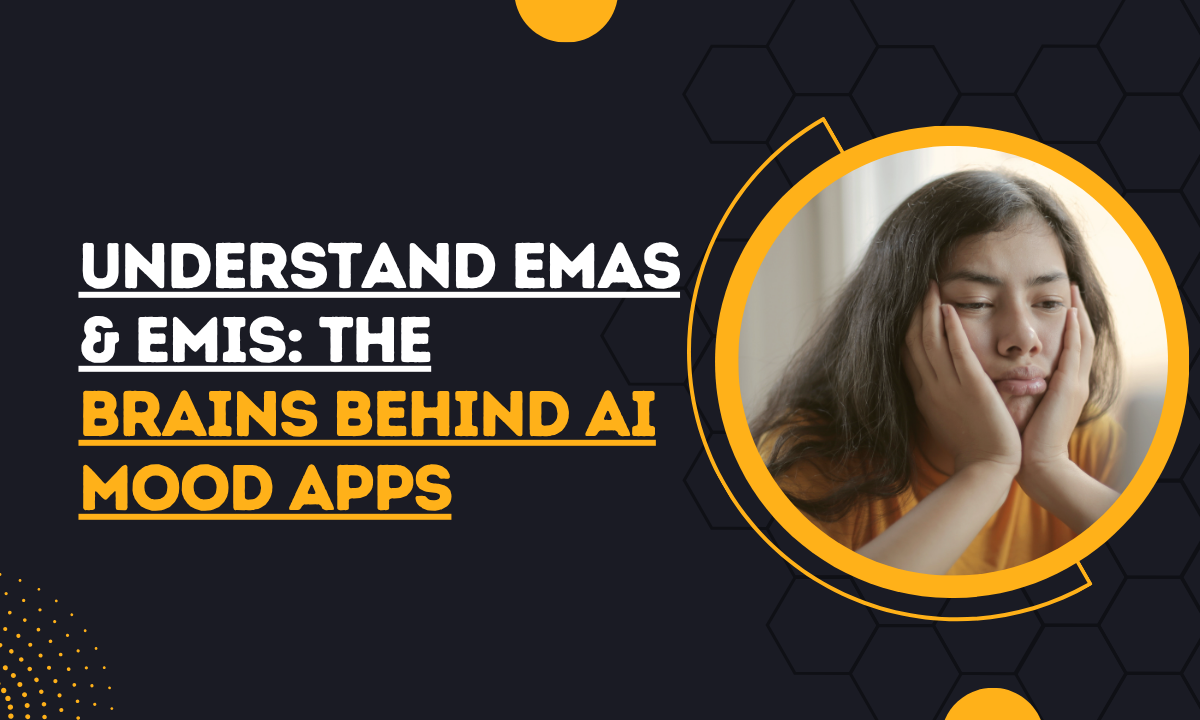Understand EMAs & EMIs: The Brains Behind AI Mood Apps
In a world where your fitness tracker knows your heart rate and your phone knows your location, it only makes sense that AI mood apps should understand your emotional state — as it happens.
That’s where Ecological Momentary Assessments (EMAs) and Ecological Momentary Interventions (EMIs) come in.
These two pillars are quietly revolutionizing the way mental health apps interact with users — not just offering afterthought support, but delivering real-time emotional intelligence.
Let’s explore how these concepts are powering the next generation of emotionally intelligent technology.
1. Why Traditional Mood Tracking Falls Short
For years, mental health journaling or mood tracking required you to pause at the end of your day and recall how you felt.
But here’s the problem: humans are poor emotional historians.
We forget the nuances, the context, the momentary spikes or dips that actually matter.
Traditional methods often miss:
- Micro-shifts in mood during the day
- Environmental triggers like crowds, deadlines, or solitude
- Real-time opportunities for self-regulation
This is where the need for real-time emotional data becomes clear.
Emotions are dynamic. So why should your emotional care be static?
To answer this, we need to understand EMAs and EMIs
2. What Are EMAs? (Ecological Momentary Assessments)

Source: MorphCast
Imagine you’re using a mental health app on your mobile phone — something like Wysa, Headspace, or Woebot.
While you go about your day, this app quietly watches for the right moment and then sends you a gentle pop-up or notification asking how you’re feeling right now.
That little question popping up — that’s called an EMA.
An EMA is a set of short, app-based questions that appear from time to time on your phone or device to check in on your mental or emotional well-being in real-time.
These questions help the app understand how you’re feeling in the moment, rather than asking you to remember your mood later.
The goal is to create a more accurate and personal picture of your mental state as it changes throughout the day.
Where Do EMAs Happen?
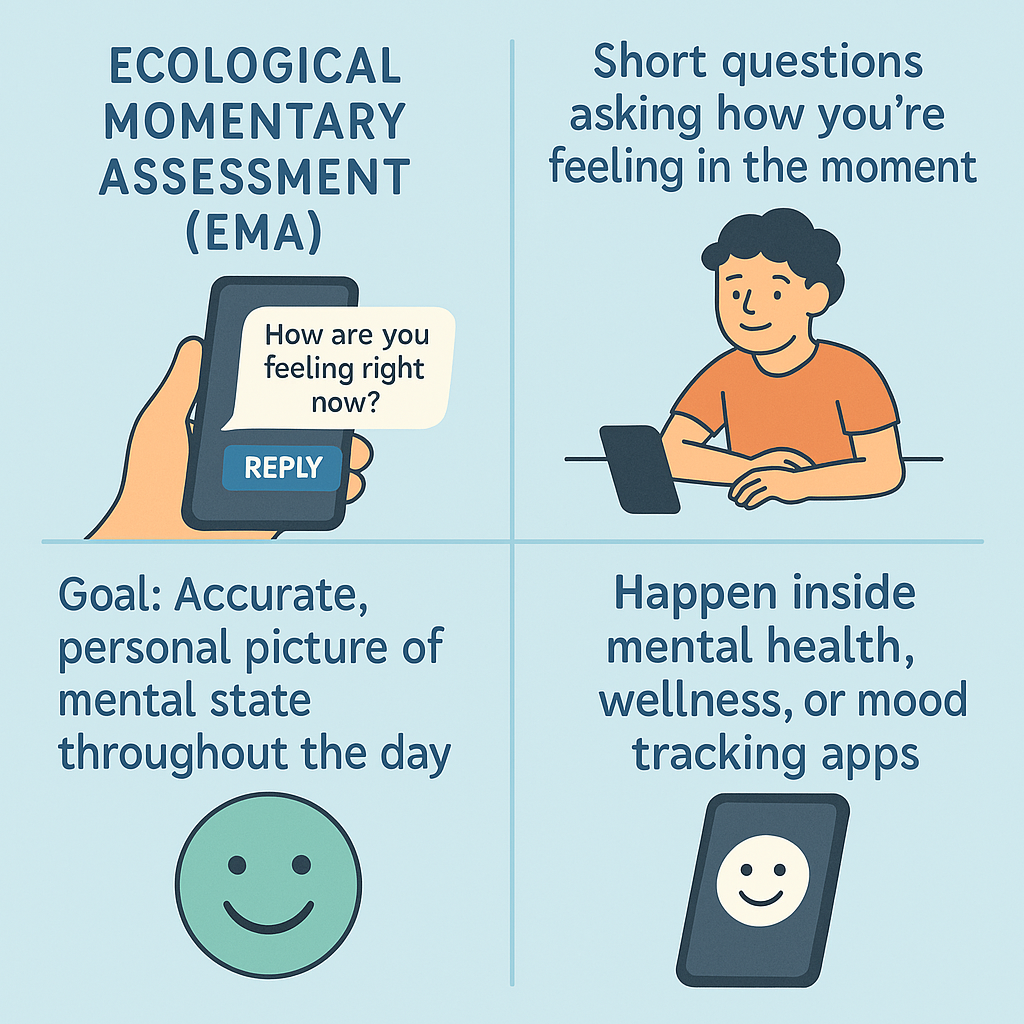
- EMAs happen inside apps you install on your smartphone or tablet.
- They are most common in mental health, wellness, or mood-tracking apps.
- You won’t find EMAs on your TV or general computer (unless using a web-based version of such apps).
What Does an EMA Actually Do?
An EMA (Ecological Momentary Assessment) is a short question or set of questions that appears during your day.
It asks you to describe how you’re feeling right at that moment — not later, not earlier.
Examples of EMA questions:
- “How are you feeling right now?”
- “What are you doing at this moment?”
- “Are you alone or with others?”
- “Is your energy low, medium, or high?”
You tap your answer on the screen, and the app saves that mood information along with the time, location, and sometimes your activity (like sitting, walking, etc.).
When Do EMAs Show Up?
EMAs aren’t random. They show up based on:
- A specific time of day (e.g., morning, afternoon, evening)
- Your location (e.g., when you reach work or get home)
- Your behavior (e.g., if you’ve been still for 2 hours, or just had a phone call)
This means the app is trying to understand how your emotions change depending on when, where, and what you’re doing.
Why Are EMAs Helpful?
Instead of asking you how you felt at the end of your day (which you might forget), EMAs catch your mood while you’re actually feeling it.
This makes your answers more:
- Accurate
- Realistic
- Useful for the app to help you better
Over time, EMAs help your app build a mood map of your life — so it knows what kind of support to give you, and when you might need help the most.
In Short:
- EMAs are questions that pop up in mental health apps.
- They ask about your mood in the moment, not later.
- They appear on your smartphone or tablet, not your TV or regular desktop.
- They help the app understand you better, so it can support you in real-time.
3.What Are EMIs? Real-Time Support That Responds to You
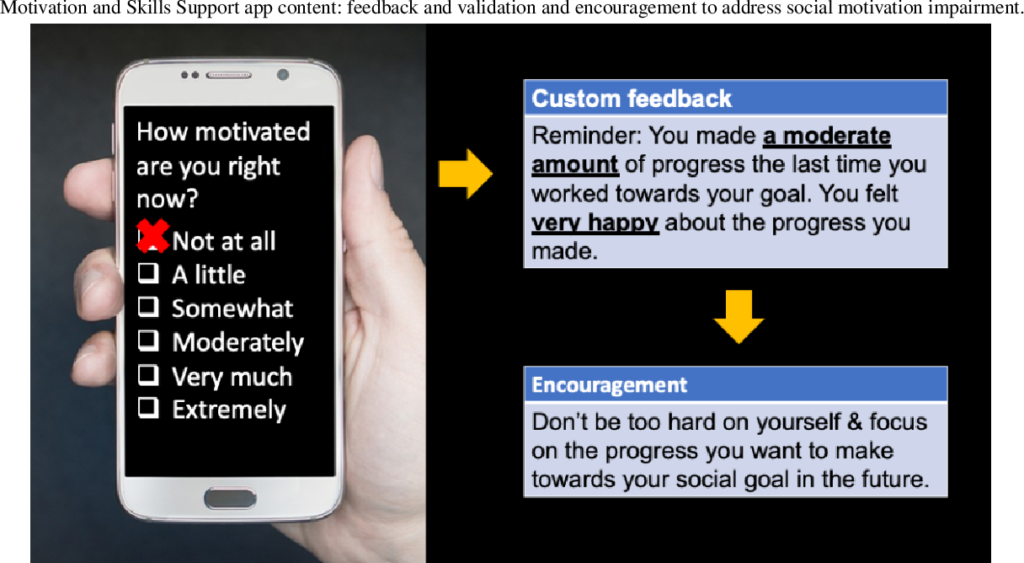
Source: SemanticScholar
From Awareness to Action
If EMAs are the sensors, EMIs are the responders.
While Ecological Momentary Assessments (EMAs) ask how you feel, Ecological Momentary Interventions (EMIs) step in to help.
These are real-time, in-app actions designed to support your emotional needs as they arise, not after you’ve already unraveled.
Think of them as instant coping tools triggered by your current emotional state.
How Do EMIs Work in AI Mood Apps?
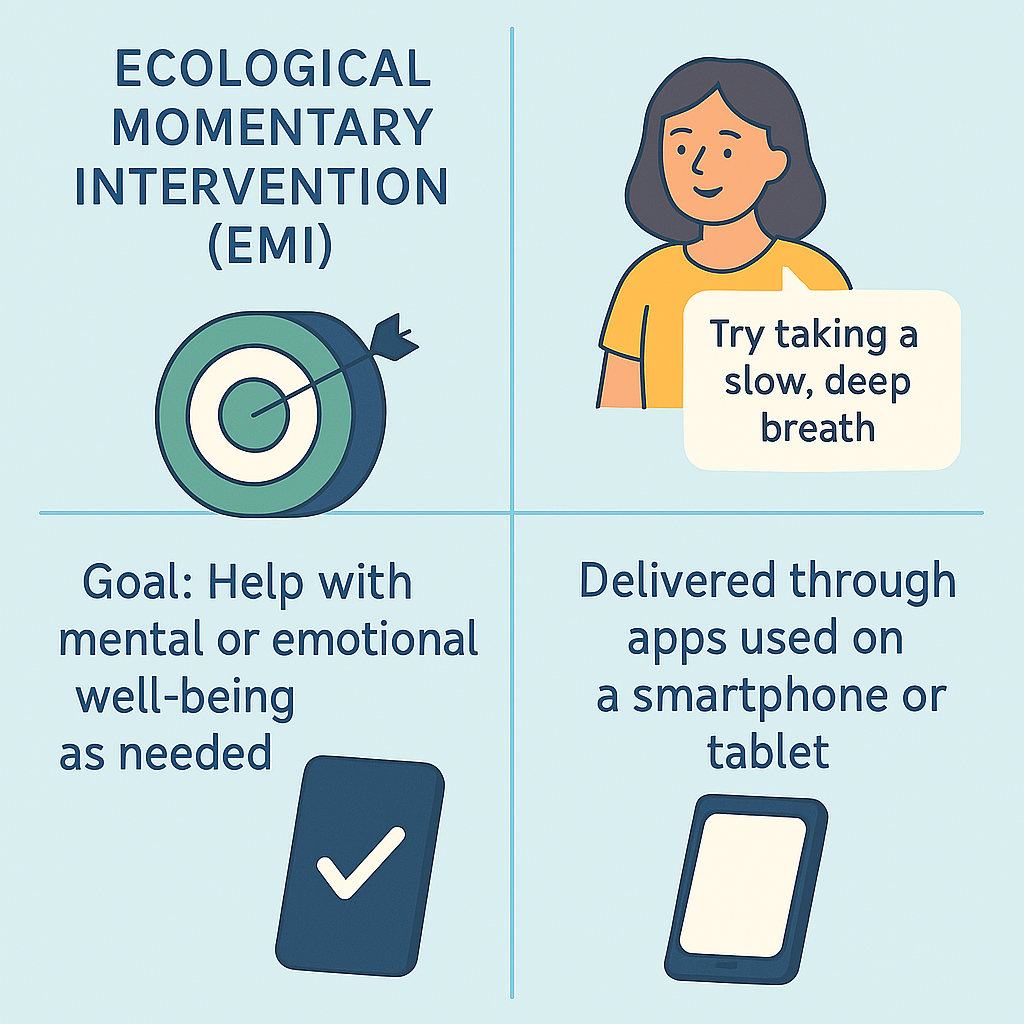
Let’s say your EMA reports rising anxiety just before a big meeting.
The app notices this pattern.
It responds instantly — not tomorrow, not in an hour.
What happens next?
You might receive:
- A 60-second breathing exercise
- A quick journaling prompt
- A soothing audio clip to ground you
That’s an EMI in action. A timely nudge when it matters most.
Unlike one-size-fits-all advice, EMIs are context-aware.
They consider your location, time of day, recent behavior, and even energy level before offering help.
Formats That Fit Your Life
What do EMIs actually look like in daily use? Here are common forms you’ll encounter:
- Mindfulness audios for calm
- Mood-reflection prompts to boost insight
- Movement reminders when you’ve been sedentary
- Gratitude nudges to shift perspective
Each one small. But powerful.
Why Timing Is Everything
Support that arrives too late often feels irrelevant.
EMIs solve that by acting within the emotional moment.
They’re not intrusive, but intuitive — designed to offer help before overwhelm sets in.
In short, EMIs turn AI mood apps from passive trackers into real-time emotional allies. That’s not just smart tech. That’s smart care.
Comparison: EMA and EMI
| Feature / Aspect | EMA (Ecological Momentary Assessment) | EMI (Ecological Momentary Intervention) |
|---|---|---|
| Purpose | To assess and record your current emotional or mental state | To offer support or guidance based on your current emotional state |
| Action Type | Passive — asks a question | Active — delivers a coping tool or intervention |
| When It Happens | At set times, during specific locations or behaviors | Right after an EMA signals distress or emotional need |
| Typical Format | Short mood-check questions like “How do you feel right now?” | Breathing exercise, audio, journaling prompt, mindfulness task |
| Goal | Understand real-time emotional patterns | Provide real-time emotional support or course correction |
| Personalization Level | Based on mood, time, place, activity | Based on mood + context (e.g., energy, behavior, time, location) |
| Use in App | To build emotional self-awareness and mood history | To offer timely, tailored mental well-being tools |
| Example Use Case | Asking about mood after a long call | Offering a calming audio when anxiety is detected before a meeting |
4. How Mood Apps Use AI for Sentiment Analysis

Source: KDNuggets
Beyond Random Check-Ins
Ever wondered how your mood app knows exactly when to step in? It’s not guessing.
It’s using AI-driven sentiment analysis to read between the lines — and act accordingly.
You may think you’re just writing “I’m fine.”
But are you really?
AI mood apps don’t just look at your words.
They analyze the context in which you use them.
Your journaling history.
The tone of your recent inputs.
Even your activity level and time of day.
Understanding Emotional Context
Here’s how it works.
The app collects small data points:
- Your text entries
- Previous moods and check-ins
- Environmental details like location, time, and movement
These are fed into a sentiment analysis engine.
Its job?
To detect emotional intent — not just the literal meaning of your words.
For example, if you’ve written three anxious entries in a row, slept poorly, and now write “I’m fine,” the app might flag that as false calm.
The result?
A deeper EMI may be triggered to support you in that very moment.
It’s not reacting to what you say — it’s responding to what you actually feel.
Your Emotional Language, Decoded
Over time, AI mood apps begin to recognize your unique emotional patterns.
They learn how you express stress, calm, or burnout — in your own way.
And that’s where the magic lies.
These apps evolve from being passive trackers to empathic, intelligent companions.
They don’t just monitor your mental health. They understand it — and respond in real time.
5. Geo, Time, and Sensor Intelligence in Mood Tracking
Smart Sensing That Knows Where, When, and How
Words aren’t the only signals your mind gives off.
The best AI mood apps now read where you are, what time it is, and what your body’s doing — all before offering emotional support.
Ever get a calming nudge just when you need it most? That’s not a lucky guess.
Geo-Awareness: Location Matters
If you’re in a crowded shopping mall, the app senses the noise and movement.
It might offer grounding techniques, rather than a high-energy pep talk. Because what you need in chaos is calm — not stimulation.
Time Sensitivity: Clocking Your Energy
It’s nearly midnight. You’re still scrolling.
The app notices and recommends a gentle reflection prompt — not a to-do list. Subtle, but smart.
Motion Detection: When Stillness Signals a Slump
Been sitting for hours?
Your phone knows.
It might suggest a short walk or light stretch — an EMI designed to re-energize you gently.
This combination of geo, time, and sensor data helps AI mood apps feel intuitive and respectful, not invasive.
They’re not interrupting — they’re responding at just the right moment.
That’s the beauty of context-aware care.
6.Benefits of EMA/EMI-Driven Mental Wellness Tools
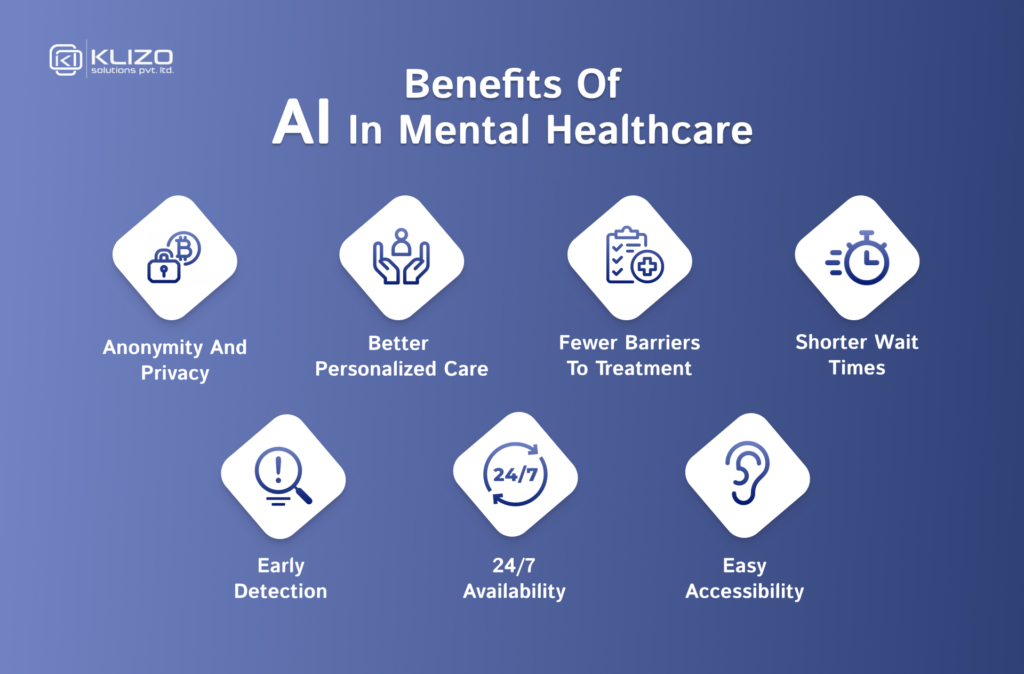
Source: Klizos.com
From Generic to Precision Mental Support
Gone are the days of one-size-fits-all advice.
Today’s AI mood apps offer tools that feel tailored to you — because they are.
Why does this matter?
Because your emotional state at 8 a.m. is rarely the same as it is at 8 p.m.
Hyper-Personalized Care
EMAs and EMIs work together to deliver support based on your mood, habits, and daily rhythm.
What you receive feels relevant in the moment, not recycled advice.
Timely Emotional Course Correction
These tools don’t just wait for a crisis.
They step in early.
A short breathing prompt or reflection exercise can redirect your emotional state before it spirals.
Boosted Self-Awareness
The more you respond to EMAs, the more patterns you start noticing.
time, you understand yourself better — often without trying.
Micro-Interventions, Maximum Impact
You don’t need an hour-long session to feel better.
Sometimes, all it takes is a smart, 90-second nudge.
In essence, EMA/EMI-driven features make AI mood apps feel less like tools — and more like quietly wise companions in your pocket.
7.Ethical Considerations and Data Privacy
When Emotion Meets Data: Who’s Protecting Whom?
AI mood apps don’t just track clicks or steps. They deal with something far more personal — your emotions. And with that comes a serious ethical responsibility.
These apps often collect detailed information about your mood patterns, thoughts, habits, and behavior. Which means? Privacy isn’t optional. It’s essential.
Transparency Over Convenience
Before diving in, ask yourself:
- Is my emotional data being anonymized?
- Does the app explain how it uses my insights?
- Can my data be sold to advertisers or third parties?
If you can’t find these answers easily, that’s a red flag.
Your Consent Should Be Clear — Not Hidden in Fine Print
The best AI mood apps use clear language around permissions and privacy.
They encrypt your data, don’t exploit it for ad revenue, and prioritize your well-being over their profits.
And yes, some apps even let you own your emotional insights.
Because in digital wellness, ethical design isn’t just a feature — it’s the foundation.
8. What to Look for in an Emotion-Aware App

Source: OpenAI Master
Choosing the Right Tool for Your Mental Well-Being
Not all mental health apps are created equal.
Especially when it comes to AI mood apps that use EMA (Ecological Momentary Assessments) and EMI (Ecological Momentary Interventions).
So how do you know which one deserves space on your phone?
Start by asking the right questions.
Must-Have Features in Emotion-Aware Apps
A good app should feel like it understands your pace — not dictate it.
Look for:
- Customizable check-ins: Can you adjust the timing, tone, or frequency of EMAs?
- Smart, context-aware EMIs: Are interventions helpful and timed well — or just random notifications?
- Offline functionality: Can you use the core tools even without internet access?
- Privacy-first data policies: Does it explain where your data goes — and who sees it?
- Evidence-based practices: Are features rooted in CBT, breathwork, or journaling science?
Don’t settle for generic.
The best AI mood apps gently fit into your lifestyle — offering support when needed, and silence when not.
Because real emotional intelligence in an app isn’t just about tech.
It’s about timing, respect, and relevance.
FAQs
1. What is the difference between EMA and EMI?
EMA collects real-time emotional data through prompts, while EMI delivers tailored support or interventions based on that data.
2. Are EMAs and EMIs based on psychology or AI?
Both. The concept originates in behavioral psychology, but modern implementations use AI for personalization, prediction, and timing.
3. Can apps really understand how I feel?
They can analyze your inputs, patterns, and context to make accurate predictions about your emotional state — though they aren’t perfect.
4. Are EMA/EMI-based apps better than journaling?
Not better, but more dynamic. Journaling is reflective; EMAs/EMIs are reactive and proactive — perfect for real-time support.
5. Do EMIs replace therapy?
No. They offer support between sessions, not a substitute for licensed mental health care.
6. How often do EMAs check in during the day?
It varies — most apps allow 2–5 check-ins per day, often adjustable. The best ones let you control the frequency and type.
Related Posts
AI Mental Health Apps: Breakthrough or Gimmick?
Are these apps delivering real emotional intelligence or just riding the AI trend? Discover what truly sets them apart.
AI Therapy Apps: 5 Mistakes You Must Avoid
From over-trusting to skipping human input—avoid these common pitfalls when using AI-powered therapy apps.
AI Mental Health Apps: The Calm Everyone Wants
Smart, intuitive, and always available—AI mental wellness apps offer calm on demand. But are they right for you?
Top 5 AI Apps for Mental Focus
Boost clarity and cut through distraction with these top-rated AI tools designed to sharpen your mental edge.
Conclusion
AI Mood Apps are transforming emotional well-being by combining real-time data, behavioral psychology, and sentiment analysis into personalized support.
Unlike traditional mood tracking, which is often delayed and general, these apps use EMAs (Ecological Momentary Assessments) and EMIs (Ecological Momentary Interventions) to respond in the moment—when support is most impactful.
Instead of simply logging moods, they identify emotional patterns, trigger timely guidance, and adapt to your lifestyle using geo, time, and motion awareness. This shift from passive recording to active, intelligent response helps build emotional resilience throughout the day.
The result is personalized care that builds self-awareness, prevents emotional dips, and supports quick recovery. These micro-interventions work quietly and effectively to manage stress or anxiety without being intrusive.
With a strong focus on consent and privacy, AI Mood Apps prioritize ethical design and human-centered care. When choosing one, look for transparency, flexibility, and tools grounded in science. Because emotional wellness today demands more than just insight—it needs timely, intelligent action.

